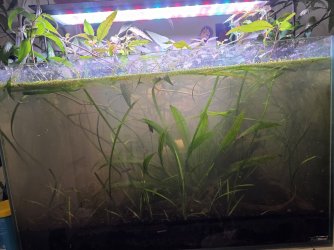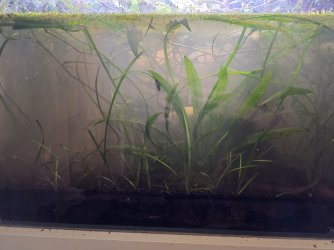Killerbro511
New Member
So for context I have had this tank set up for at least 4 years and at some point a while ago I stopped gravel vacuuming because i felt it was kind of uneeded with how heavily planted the tank was. The water has always had a yellowish tint that I never have been able to remove and my LFS and I think its due to high sulphates in my tap water.
So cut to a few weeks ago I decided to buy some more corys and glowlights for my tank and decided itd be a good idea to do a water change before acclimating them and I ended up gravel vaccing a little portion of the tank however little did I know that itd cause a massive headache. There was what I believed to be a natural bacteria bloom after the addition of the extra livestock however after that usual white cloudiness dissipated a permanent darker haze was established. I reckon its due to fine gunk from the substrate being constantly in the water column however I thought after ive done atleast 5 water changes and constant filter media cleaning to remove the excess gunk itd improve but apparently not so im really in need of ideas on how to fix this without having to reset everything. I have thought about trying to vac every last bit of the substrate until none of the gunk remains but whenever I do that it seems to have little to no effect.
I post this in the emergency forum because since this started, one of my glow lights and one of my oldest corydoras dies and the kuhlis I also have in here seem to glass surf a lot more than usual (opposed to the typical hiding) so I'm concerned about how much longer things can remain like this without a massive die off. I also have no way to test my water but after the amount of water changes ive done in the last few weeks (40% per) I doubt ammonia or nitrates are a problem.
Any help would be greatly appreciated!
So cut to a few weeks ago I decided to buy some more corys and glowlights for my tank and decided itd be a good idea to do a water change before acclimating them and I ended up gravel vaccing a little portion of the tank however little did I know that itd cause a massive headache. There was what I believed to be a natural bacteria bloom after the addition of the extra livestock however after that usual white cloudiness dissipated a permanent darker haze was established. I reckon its due to fine gunk from the substrate being constantly in the water column however I thought after ive done atleast 5 water changes and constant filter media cleaning to remove the excess gunk itd improve but apparently not so im really in need of ideas on how to fix this without having to reset everything. I have thought about trying to vac every last bit of the substrate until none of the gunk remains but whenever I do that it seems to have little to no effect.
I post this in the emergency forum because since this started, one of my glow lights and one of my oldest corydoras dies and the kuhlis I also have in here seem to glass surf a lot more than usual (opposed to the typical hiding) so I'm concerned about how much longer things can remain like this without a massive die off. I also have no way to test my water but after the amount of water changes ive done in the last few weeks (40% per) I doubt ammonia or nitrates are a problem.
Any help would be greatly appreciated!





